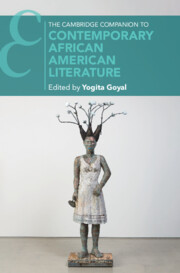Book contents
- The Cambridge Companion to Contemporary African American Literature
- The Cambridge Companion to Contemporary African American Literature
- Copyright page
- Contents
- Contributors
- Acknowledgments
- Chronology
- Introduction
- Part I Histories of the Present
- Part II African American Genres
- Part III Mapping New Identities and Geographies
- Part IV Critical Approaches
- 13 African American Soundscapes
- 14 African American Literature and Visual Culture
- 15 The Affective Turn
- 16 Print Culture and Literary Sociology
- 17 Digital and New Media Cultures of Protest
- Further Reading
- Index
- Cambridge Companions To …
14 - African American Literature and Visual Culture
from Part IV - Critical Approaches
Published online by Cambridge University Press: 14 December 2023
- The Cambridge Companion to Contemporary African American Literature
- The Cambridge Companion to Contemporary African American Literature
- Copyright page
- Contents
- Contributors
- Acknowledgments
- Chronology
- Introduction
- Part I Histories of the Present
- Part II African American Genres
- Part III Mapping New Identities and Geographies
- Part IV Critical Approaches
- 13 African American Soundscapes
- 14 African American Literature and Visual Culture
- 15 The Affective Turn
- 16 Print Culture and Literary Sociology
- 17 Digital and New Media Cultures of Protest
- Further Reading
- Index
- Cambridge Companions To …
Summary
Understanding contemporary African American literature, this chapter argues, requires accounting for the rich, multifaceted dialogue between Black literary production and the visual arts. This chapter traces what Toni Morrison called the “alliances and alignments” between literature and the other arts by analyzing the aesthetics and themes of contemporary African American writing and examining the cross-arts influences that shaped it. The dialogue between African American literature and visual culture is part of a much longer tradition, and contemporary writers have built on many earlier precedents. But this chapter also unpacks how important historical changes, including developments in media technology and the rise of Black art institutions, have generated new and more numerous intersections between Black literary and artistic cultures since the 1970s. Focusing on three key spaces that provided material support and thematic inspiration for Black writers’ experiments with visual art – the home, museum, and university – this chapter examines how authors working in a range of literary genres, including novels, poetry, plays, screenplays, memoirs, and essays, engaged with a variety of visual arts, including painting, film, sculpture, and photography. The influences and aesthetics of visual culture, the chapter shows, powerfully infuse the work of many writers today.
Keywords
- Type
- Chapter
- Information
- Publisher: Cambridge University PressPrint publication year: 2023



